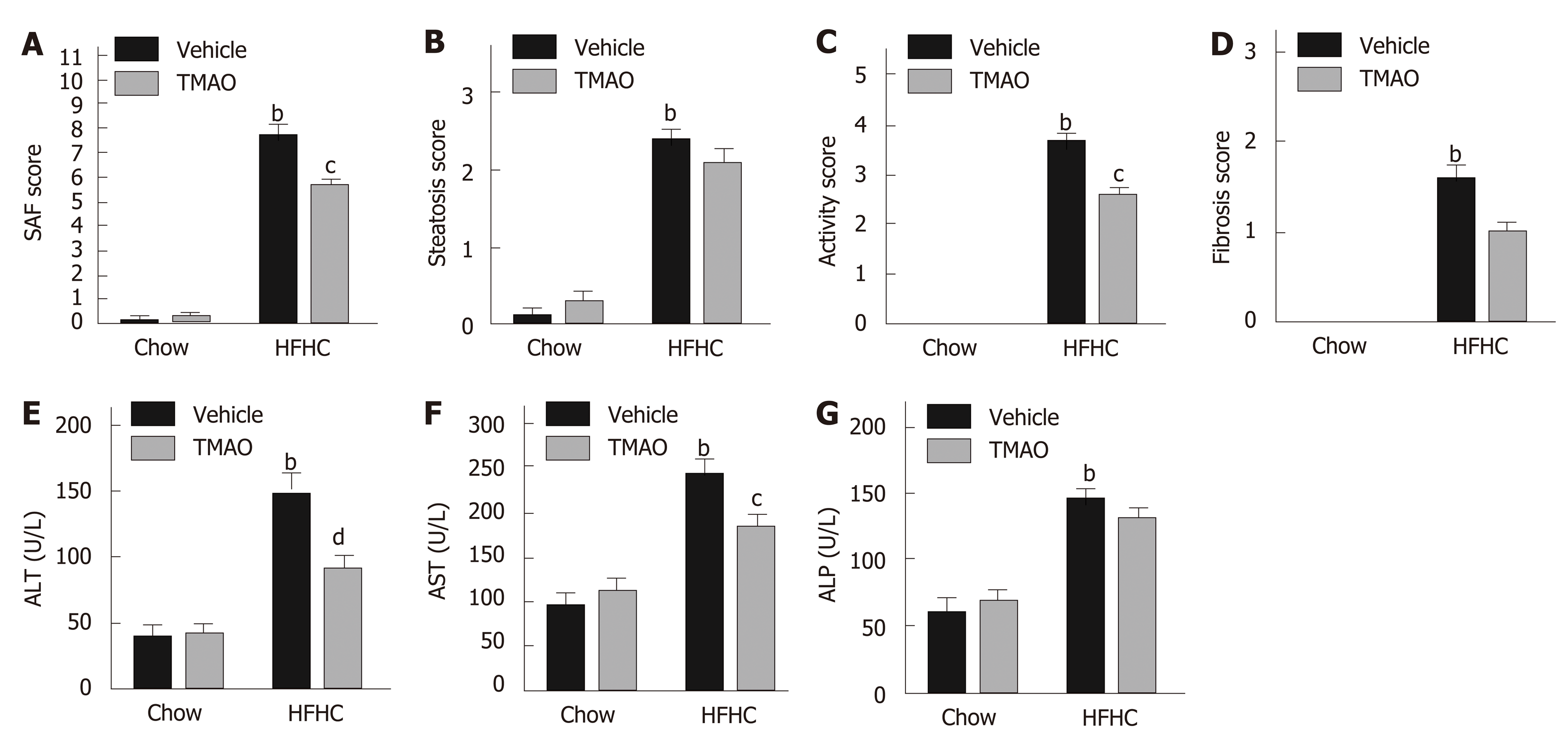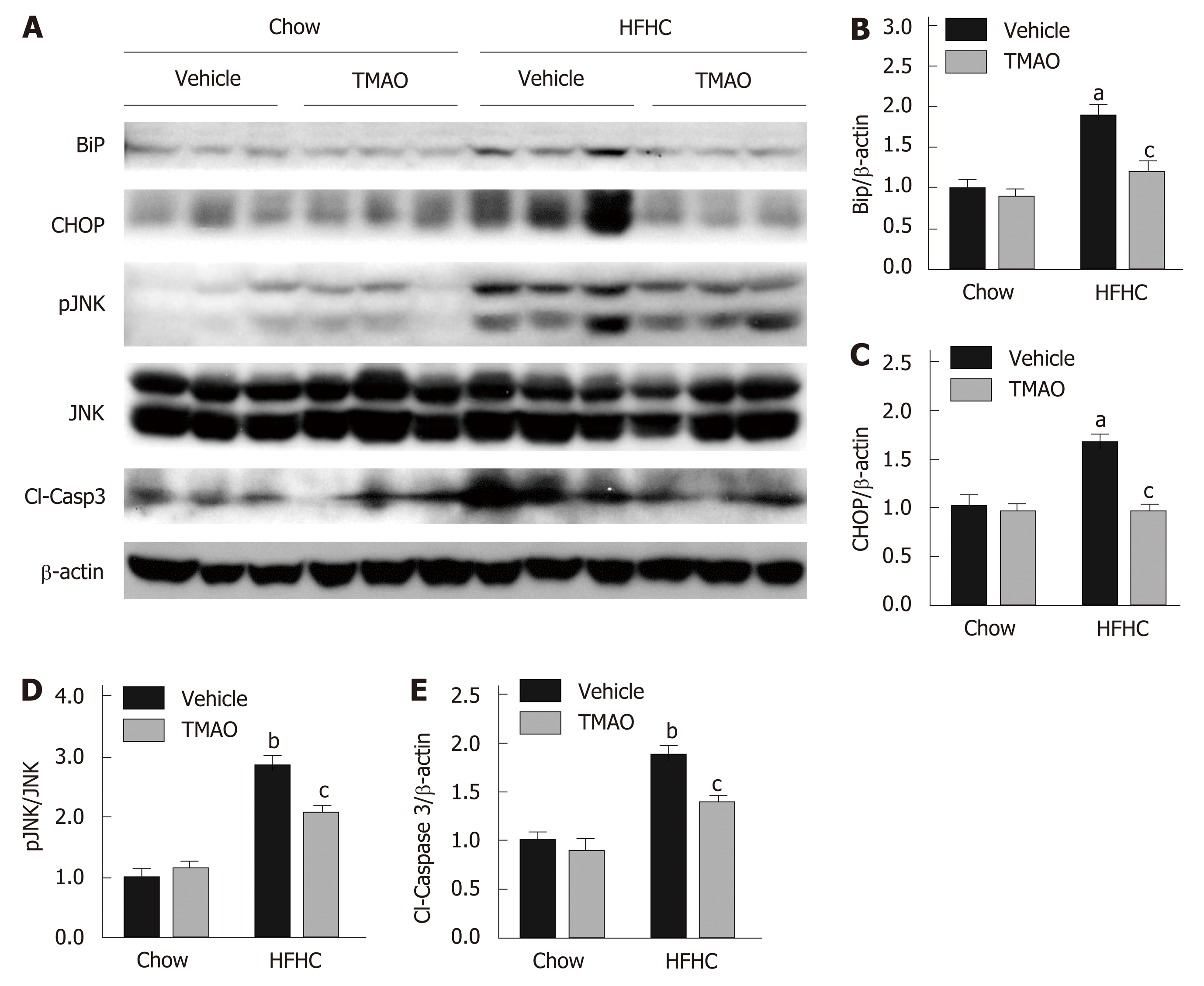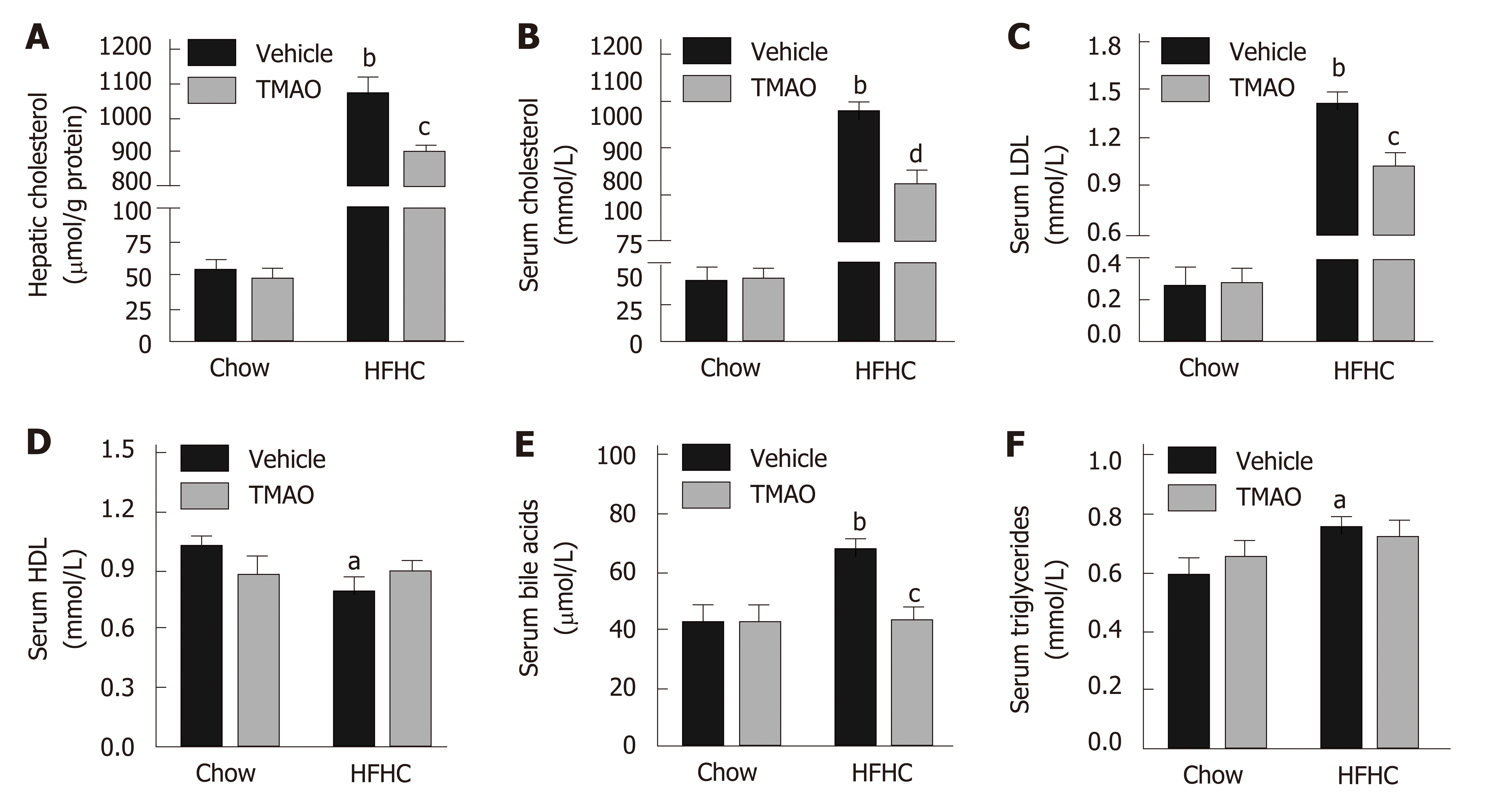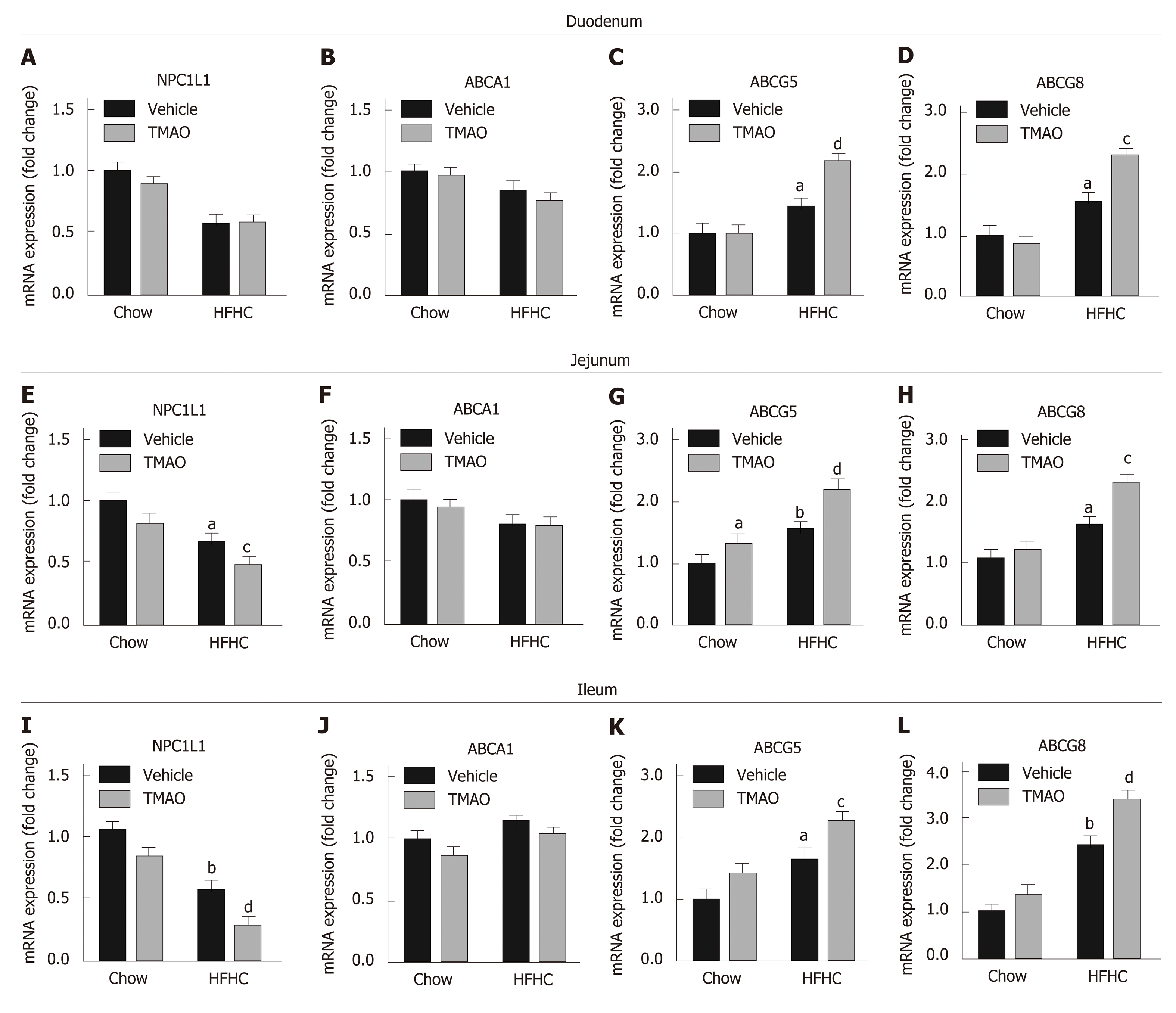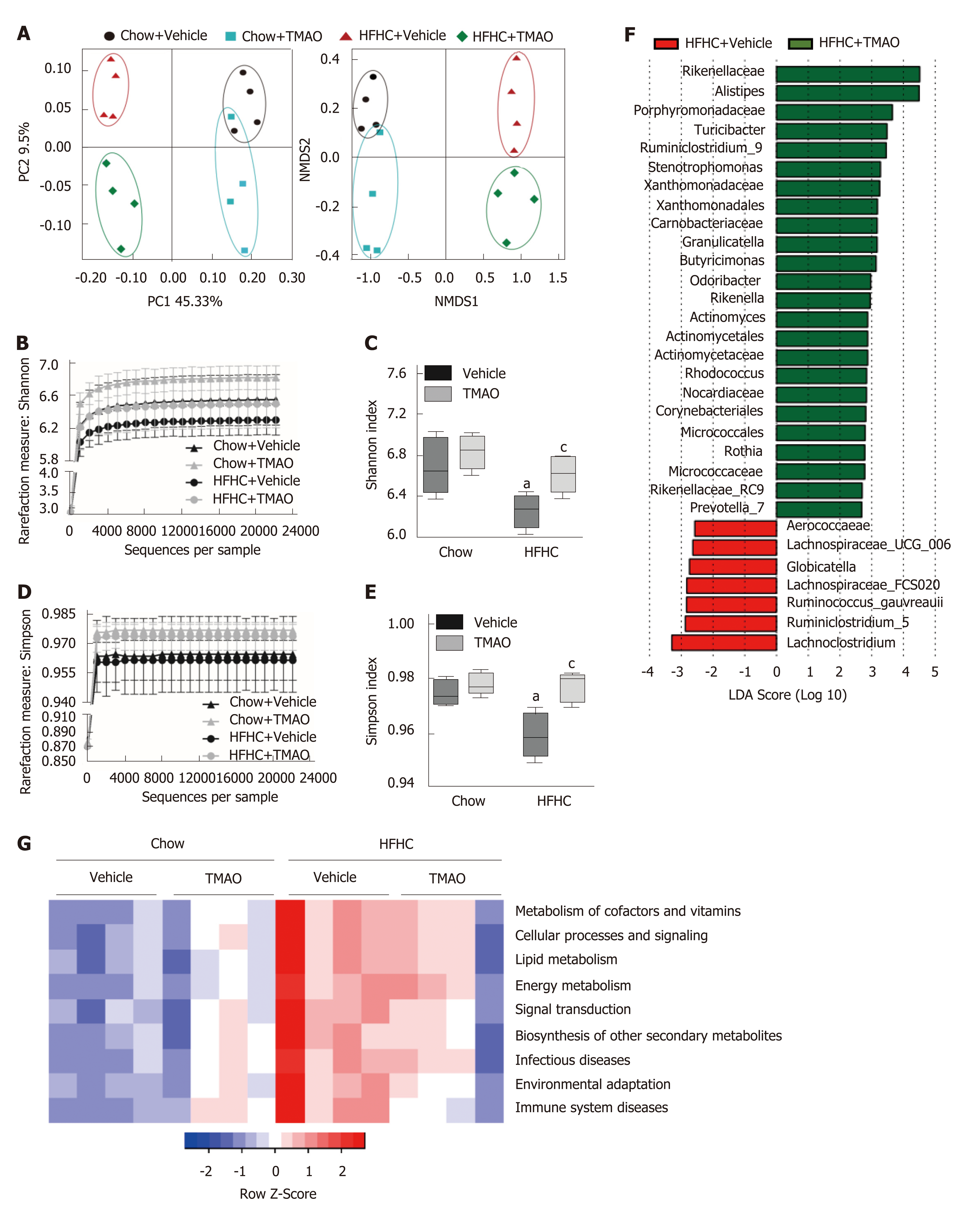Copyright
©The Author(s) 2019.
World J Gastroenterol. May 28, 2019; 25(20): 2450-2462
Published online May 28, 2019. doi: 10.3748/wjg.v25.i20.2450
Published online May 28, 2019. doi: 10.3748/wjg.v25.i20.2450
Figure 1 Trimethylamine N-oxide attenuates histological alterations with little effect on body weight in high-fat high-cholesterol diet-induced steatohepatitis.
Six-week-old male rats were fed a high-fat high-cholesterol diet for 8 wk and then gavaged with trimethylamine N-oxide (120 mg/kg/day) once daily for 8 wk. Rats were sacrificed at the end of the 16th wk. A: Schematic illustration showing the design of the in vivo experiment; B: The body weight curves; C: The body weight at the 16th wk before sacrifice; D: The liver index; E: Epididymal white adipose tissue index; F: Representative hematoxylin and eosin staining of liver tissue. The data are presented as the mean ± SE (n = 10-14). aP < 0.05, vs rats fed a chow diet; bP < 0.01, vs rats fed a chow diet; cP < 0.05, vs rats fed a high-fat high-cholesterol diet; dP < 0.01, vs rats fed a high-fat high-cholesterol diet. eWAT: Epididymal white adipose tissue; TMAO: Trimethylamine N-oxide; HFHC: High-fat high-cholesterol.
Figure 2 Trimethylamine N-oxide reduces the activity of steatohepatitis and improves the serological alterations in rats fed a high-fat high-cholesterol diet.
A: The steatosis, activity, and fibrosis scores; B: The scores of steatosis; C: The scores of activity; D: The scores of fibrosis; E: Serum levels of alanine transaminase; F: Serum levels of aspartate transaminase; G: Serum levels of alkaline phosphatase. The data are presented as the mean ± SE (n = 8-10). aP < 0.05, vs rats fed a chow diet; bP < 0.01, vs rats fed a chow diet; cP < 0.05, vs rats fed a high-fat high-cholesterol diet; dP < 0.01, vs rats fed a high-fat high-cholesterol diet. SAF: Steatosis, activity, and fibrosis; ALT: Alanine transaminase; AST: Aspartate transaminase; ALP: Alkaline phosphatase; TMAO: Trimethylamine N-oxide; HFHC: High-fat high-cholesterol.
Figure 3 Trimethylamine N-oxide alleviates liver injury by mitigating hepatic endoplasmic reticulum stress and cell death in rats fed a high-fat high-cholesterol diet.
A: Representative immunoblots from three rats in each group; B-E: Densitometric quantification from three rats in each group. Relative protein levels normalized to β-actin except for phosphorylated c-Jun N-terminal kinase (JNK), which was normalized to endogenous JNK. The data are presented as the mean ± SE (n = 3). aP < 0.05, vs rats fed a chow diet; bP < 0.01, vs rats fed a chow diet; cP < 0.05, vs rats fed a high-fat high-cholesterol diet; dP < 0.01, vs rats fed a high-fat high-cholesterol diet. JNK: c-Jun N-terminal kinase; TMAO: Trimethylamine N-oxide; HFHC: High-fat high-cholesterol.
Figure 4 Trimethylamine N-oxide reduces hepatic cholesterol overload and improves serum lipid profile in rats fed a high-fat high-cholesterol diet.
A: Hepatic levels of cholesterol; B: Serum levels of cholesterol; C: Serum levels of low-density lipoprotein; D: Serum levels of high-density lipoprotein; E: Serum levels of bile acids; F: Serum levels of triglycerides. The data are presented as the mean ± SE (n = 8-10). aP < 0.05, vs rats fed a chow diet; bP < 0.01, vs rats fed a chow diet; cP < 0.05, vs rats fed a high-fat high-cholesterol diet; dP < 0.01, vs rats fed a high-fat high-cholesterol diet. LDL: Low-density lipoprotein; HDL: High-density lipoprotein; TMAO: Trimethylamine N-oxide; HFHC: High-fat high-cholesterol.
Figure 5 Trimethylamine N-oxide modulates the expression of intestinal cholesterol transporters to inhibit cholesterol absorption in rats fed a high-fat high-cholesterol diet.
A-D: Expression levels of cholesterol transporters in the duodenum; E-H: Expression levels of cholesterol transporters in the jejunum; I-L: Expression levels of cholesterol transporters in the ileum. The data are presented as the mean ± SE (n = 7-8). aP < 0.05, vs rats fed a chow diet; bP < 0.01, vs rats fed a chow diet; cP < 0.05, vs rats fed a high-fat high-cholesterol diet; dP < 0.01, vs rats fed a high-fat high-cholesterol diet. TMAO: Trimethylamine N-oxide; HFHC: High-fat high-cholesterol; NPC1L1: Niemann-Pick C1-Like 1; ABCA1: ATP-binding cassette transporter A1; ABCG: ATP-binding cassette subfamily G member.
Figure 6 Diversity of gut microbiota is restored by trimethylamine N-oxide treatment in rats fed a high-fat high-cholesterol diet.
A: The beta diversity of the gut microbiota (n = 4); B: The rarefaction curve of the Shannon measurement (n = 4); C: Index bar of the Shannon measurement (n = 4); D: The rarefaction curve of the Simpson measurement (n = 4); E: Index bar of the Simpson measurement (n = 4); F: Linear discriminant analysis coupled with effect size measurements analysis (n = 4); G: Prediction of the functional genes in the sampled bacterial community using phylogenetic investigation of communities by reconstruction of unobserved states (n = 4). aP < 0.05, vs rats fed a chow diet; bP < 0.01, vs rats fed a chow diet; cP < 0.05, vs rats fed a high-fat high-cholesterol diet; dP < 0.01, vs rats fed a high-fat high-cholesterol diet. TMAO: Trimethylamine N-oxide; HFHC: High-fat high-cholesterol.
- Citation: Zhao ZH, Xin FZ, Zhou D, Xue YQ, Liu XL, Yang RX, Pan Q, Fan JG. Trimethylamine N-oxide attenuates high-fat high-cholesterol diet-induced steatohepatitis by reducing hepatic cholesterol overload in rats. World J Gastroenterol 2019; 25(20): 2450-2462
- URL: https://www.wjgnet.com/1007-9327/full/v25/i20/2450.htm
- DOI: https://dx.doi.org/10.3748/wjg.v25.i20.2450










